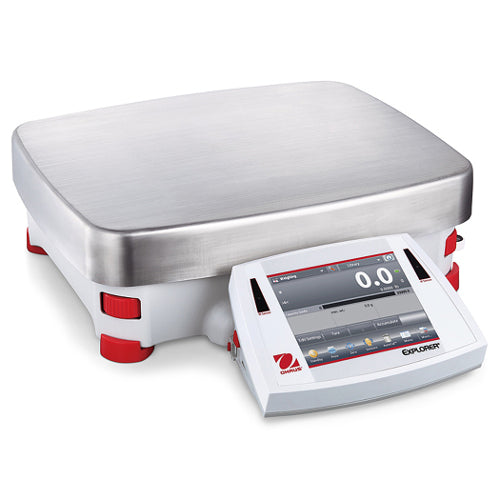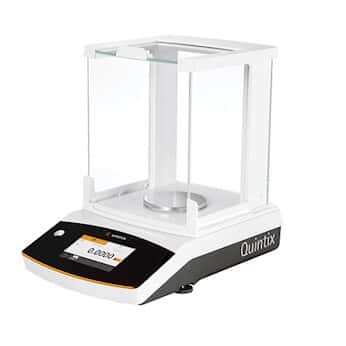62 Products
Collection: Precision Balances
Filter products
- Shop By Brand
- Balances and Scales
- Rentals
- Lab Equipment
- Consumables
- Services
- Contact Us
- Service Request
- Order Status
How to perform routine testing on a precision balance?
Performing routine testing on a precision balance is essential for ensuring accurate and reliable results. To successfully conduct routine testing on a precision balance, it is important to begin with proper user training. This training will enable you to execute routine testing procedures accurately. Three critical tests must be carried out to verify the performance of your precision balance: repeatability, sensitivity, and eccentricity.When performing routine testing, four key aspects should be taken into consideration: test frequency, test methods, test weights, and test tolerances. It is crucial to determine the appropriate frequency at which these routine tests should be conducted. Additionally, understanding the correct methodology for each test is vital in obtaining accurate results. Selecting the suitable test weights and ensuring they adhere to set tolerances are also crucial factors in routine testing.For in-depth insights on correctly performing routine testing on a precision balance, it is recommended to explore additional resources such as the Routine Testing Webinar, a comprehensive guide that provides detailed information on the testing process. Furthermore, a quick summary of the testing procedures can be found in the accompanying video. You can also access a step-by-step Routine Testing Guide for detailed instructions on conducting the tests effectively.To further enhance your understanding of the test methods, consider referring to the Standard Operating Procedures (SOPs) specifically designed for sensitivity, repeatability, and eccentricity testing. By following these guidelines and utilizing the available resources, you can ensure that the routine testing on your precision balance is carried out accurately and reliably.
What are the different types of precision balances?
Different types of precision balances available in the market cater to various weighing needs. These types can be broadly categorized based on features such as platform size, performance level, readability, decimal places, capacity range, and pan type.1. **Large Platform Precision Balances:** These balances feature a large weighing platform suitable for heavy and bulky loads. They generally offer a readability ranging from 1 g to 1 mg, with a capacity range of 12.1 kg to 64.1 kg. The weighing pan is usually a rectangular pan SmartPan designed for large items.2. **Small Platform Precision Balances:** Designed with a small weighing platform to accommodate standard loads and smaller items, these balances typically provide a readability of 1 g to 1 mg. The capacity range for this type usually falls between 310 g and 10.1 kg, with a rectangular pan SmartPan for weighing.3. **High-Performance Large Platform Precision Balances:** These balances are carefully selected for their exceptional repeatability at higher capacities. They offer a readability of 1 mg and can handle weights ranging from 26.1 kg to 64.1 kg. These balances come with a LevelMatic weighing pan suitable for larger items.4. **High-Performance Small Platform Precision Balances (with draft shield):** Similarly chosen for exceptional repeatability at higher capacities, these precision balances provide a readability of 0.1 mg. They can weigh items ranging from 2.3 kg to 10.1 kg and are equipped with a LevelMatic weighing pan for smaller loads.5. **Precision Balances with Draft Shield:** These balances feature higher readability for weighing smaller loads accurately. They usually offer a readability of 1 mg to 0.1 mg and can handle capacities ranging from 101 g to 5.1 kg. The weighing pans for this type are available in circular, square, or SmartPan designs.6. **Portable Precision Balances:** Ideal for on-the-go weighing needs, portable precision balances are lightweight and can be battery-operated. They offer a readability of 100 mg to 10 mg, with a capacity range of 220 g to 6.2 kg. The weighing pan for this type is typically circular in shape.
What is the difference between a precision balance and an analytical balance?
The main difference between a precision balance and an analytical balance lies in their respective levels of readability. A precision balance, also referred to as a precision scale, typically provides measurements with a readability ranging from 0 to 3 decimal places, which means it can measure weights from 1 gram down to 1 milligram. On the other hand, an analytical balance is characterized by its higher level of precision, offering a readability of 4 decimal places or more, typically measuring weights as low as 0.1 milligram
Can I use my precision balance touchscreen while wearing gloves?
Yes, you can use METTLER TOLEDO precision balances and precision scales while wearing gloves. These devices are designed with a glove mode feature that allows you to operate the touchscreen even when wearing gloves, including reusable rubber, neoprene, and disposable nitrile, latex, or vinyl gloves. The glove mode optimizes the touchscreen for use with various types of gloves, ensuring that you can protect yourself from harmful substances and prevent sample contamination while weighing. For more information on weighing with gloves, you can refer to the instructions provided for glove mode activation on your device.
Which precision balance model is suitable for weighing large loads and bulky items?
The precision balance model that is most suitable for weighing large loads and bulky items is the one equipped with a larger weighing pan. These large platform precision balances come in different capacities ranging from 10 kg up to 64 kg to accommodate the varying sizes of loads. They also offer different decimal place readabilities, including options for 1 g, 0.1 g, 0.01 g, and even 0.001 g to provide high accuracy when weighing. The choice of the specific capacity and readability of the precision balance will depend on the unique requirements of your application when weighing large and bulky items.
How do I clean my precision balance/precision scale?
To clean your precision balance or precision scale, start by choosing the appropriate cleaning agent based on the specific requirements of your laboratory or workplace. The cleaning agent should effectively remove any residue without causing damage to the delicate components of the balance. It is recommended to clean the balance after each use or change of weighing substance, but the frequency may vary depending on the industry and usage patterns. You can refer to the cleaning SOP for guidance on the recommended cleaning schedule.For a standard cleaning procedure, follow these steps:1. Ensure you have necessary protection and refer to the cleaning SOP.2. Disconnect the balance from the power source.3. Clean the area surrounding the balance to prevent contamination.4. Detach any removable parts for thorough cleaning.5. Clean the balance's surfaces carefully using an appropriate cleaning agent.6. Reassemble the balance once cleaning is complete.7. Verify that the balance is prepared for further use.For detailed instructions on how to clean your precision balance, including recommended cleaning methods, appropriate cleaning agents, and maintenance tips, you can access our comprehensive guide titled "8 Steps to a Clean Balance," which also includes a cleaning SOP for your convenience.
How to choose the best precision balance for laboratory and manufacturing applications?
Choosing the best precision balance for laboratory and manufacturing applications involves considering several key factors to ensure accurate weighing results that meet specific requirements. It is important to assess the unique conditions and challenges of the weighing environment, such as vibrations, drafts, dirt, and the presence of multiple operators, as these factors can impact the performance of the balance.
To select the right precision balance, key considerations include the maximum weight that needs to be measured, the smallest net weight that requires precision weighing, the acceptable weighing tolerance specified as a percentage, and the safety factor to account for potential variations and risks associated with inaccurate weighing results.
Utilizing services like METTLER TOLEDO's GWP (Good Weighing Practice) Recommendation can assist in choosing the suitable precision balance for laboratory or manufacturing applications. This service helps in evaluating the aforementioned factors to match the requirements of the weighing process and ensure that the balance is fit for purpose.
By taking into account these critical factors and leveraging expert recommendations, one can confidently select the best precision balance that will provide accurate and reliable weighing results for laboratory and production environments.
What is the accuracy of precision balances?
The accuracy of precision balances is determined by the combination of their trueness and precision. Trueness measures how closely the values measured on a precision balance align with the well-defined mass of a calibrated test weight. Precision, on the other hand, describes the range of variation in repeated measurements conducted under the same conditions using the same precision balance. Repeatability, a key aspect of precision, is often listed on datasheets and should not be mistaken for readability. Precision balances typically offer a high level of readability, down to 0.1 mg, which serves as an initial indicator of their performance.
Do I need to calibrate my precision balance?
Calibration of a precision balance is essential to ensure its performance meets required standards. The need for calibration depends on the specific environment in which the balance is used and any relevant regulations that may apply. In certain regulated settings, calibration is mandatory to confirm that the balance functions correctly. Authorized service technicians are responsible for performing calibration, while routine testing is typically conducted by the user. Regular testing is crucial as it helps identify any deviations in the balance's performance that could result in inaccurate measurements.
What is overload protection on my precision balance?
Overload protection on a precision balance is a critical safety feature designed to safeguard the weighing cell from damage when objects that exceed the balance capacity are placed on the weighing pan. This protection mechanism helps prevent any harm to the sensitive weighing cell in situations where the weight limit is exceeded, either intentionally or accidentally. When the balance capacity is surpassed, a warning is displayed on the balance screen to alert the user. It is important to note that all METTLER TOLEDO precision balances and precision scales come equipped with overload protection to ensure the durability and accuracy of the weighing equipment.
What is the maximum load I can weigh on my precision balance?
The maximum load you can weigh on your precision balance is determined by the capacity of the balance or scale you are using. Precision balances from METTLER TOLEDO come in various capacities, ranging from 120 grams up to 64 kilograms. The model name of the balance typically indicates its capacity. For instance, the XPR4002S has a capacity of 4.1 kilograms with a readability of 0.01 grams, while the MX8001 can handle up to 8.2 kilograms with a readability of 0.1 grams. It is important to note that the maximum load includes both the weight of any container used and the sample being weighed.
Where are precision balances and precision scales used? What are the application areas of precision balances?
Precision balances and precision lab scales find extensive use in various settings, primarily in laboratories and manufacturing facilities. These instruments are essential for tasks requiring precise weighing, such as weighing items, sample preparation, piece counting, statistical quality control, formulation, sieve analysis, differential weighing, dynamic weighing, and interval weighing.
Primarily, precision balances serve in general laboratories, research and development facilities, and quality control departments across a wide array of industries, including chemical, pharmaceutical, food, textiles, metals, plastics, and academia. Additionally, high-capacity precision balances with weight capacities exceeding 10 kg feature spacious weighing platforms to accommodate larger loads. These high-capacity balances are especially prevalent in applications involving aggregates, pharmaceuticals, chemicals, adhesives formulation, and similar industries.
























